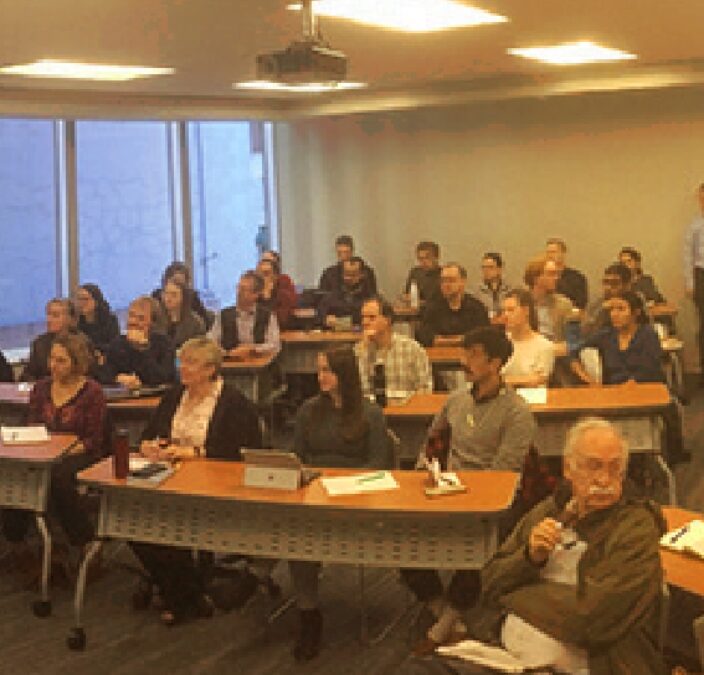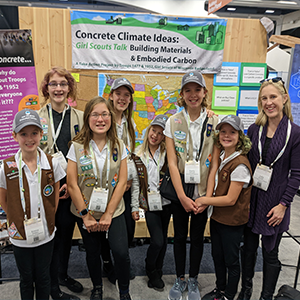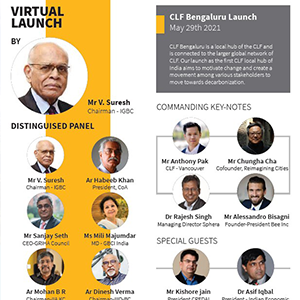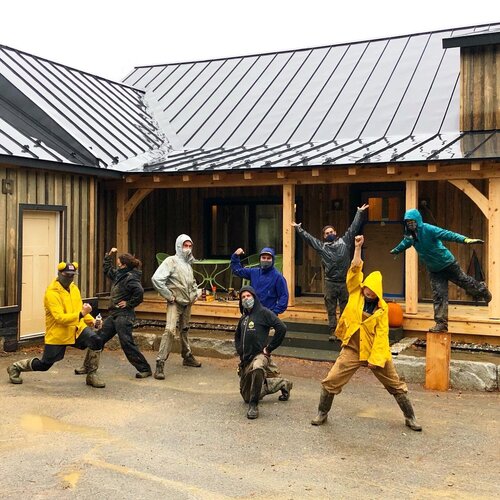„Alle Bauingenieure müssen den in ihren Projekten enthaltenen Kohlenstoff bis 2050 verstehen, reduzieren und letztendlich eliminieren.“
Conceived of and developed by members of the Carbon Leadership Forum — including Duncan Cox (Thornton Tomasetti), Catherine De Wolf (MIT/EPFL), Amy Hattan (Thornton Tomasetti), Erin McDade (Architecture 2030), Kate Simonen (Carbon Leadership Forum/UW), Wil Srubar (U Colorado Boulder), and Frances Yang (Arup) — the SE 2050 Challenge was designed to ignite structural engineers and their firms to meet embodied carbon benchmarks and ambitious reduction goals, and be recognized for the significant role they can play towards these targets.

Ein Sitz in der ersten Reihe für die Entwicklung der Herausforderung
durch Frances Yang
Associate und Nachhaltigkeitsberater bei Arup in San Francisco
The journey of the SE 2050 Initiative began four years ago, catalyzed by several streams of activity heading in the same direction. The seven individuals who started the initiative had two primary motivations: we wanted to inspire and engage structural engineers to drive down embodied carbon in their designs, and to contribute data to establish benchmarks and targets. The Carbon Leadership Forum had just completed a umfassende Benchmarking-Studie Dabei wurde die Notwendigkeit erkannt, systematischer und organisierter mehr Daten zu sammeln, um verkörperte Kohlenstoffziele für die Architektur 2030 festzulegen.
Arup was invited to join due to multiple touch points. Our own history included an internal effort starting in 2009 to obtain embodied carbon benchmarks by compiling data from over 80 projects from publicly available case studies plus our own. This also formed the start of an internal project tracking effort. When the CLF needed data for Architecture 2030 targets we were able to offer more than 400 data points for the bench-marking study. In parallel, Arup had also helped to create the UK WRAP (now RICS) Embodied Carbon Database, and assisted the development of the MIT material quantities database. These activities reflect Arup’s decades-long commitment to sustainability and the firm’s belief that addressing total carbon in the built environment is essential to its mission to “shape a better world.”
While the seven of us were advancing our organizations in our own ways, we realized that by coming together we could jump start a program to reach the entire structural engineering community. Inspired by the AIA 2030 Verpflichtung, we saw that a program to motivate, equip, and keep firms accountable — while also providing useful data to scientific and policy communities — would be essential for any hopes of reaching net zero embodied carbon by 2050. The CLF provided the incubation space for us to initiate SE 2050.
Unter der Schirmherrschaft des CLF haben wir die SE 2050 Herausforderung. Wir konnten das CLF-Netzwerk nutzen, um in nur 4 Wochen 140 Unterschriften von Bauingenieuren und Unterstützern zu sammeln Institut für Bauingenieurwesen (SEI) to commit to “understand, reduce and ultimately eliminate embodied carbon in their projects by 2050.” We reached out directly to the SEI Sustainability Committee, and were elated to see the committee quickly form the SE 2050 Working Group. In short order, the Working Group secured an all-day meeting with members of SEI’s Board of Governors, created an astounding website, and officially launched the beta-phase of the SE 2050 Commitment Program. The CLF was also critical at the face-to-face meeting with SEI leadership. Alongside its longtime partners from the AIA, Architecture 2030, and USGBC, the CLF brought both urgency and invitation never before directed to our national structural engineering organization on matters of our climate crisis. SEI endorsed the SE 2050 Challenge a few months later.
As someone who was in the SE 2050 incubation group, and is now on the SEI SE 2050 committee, I am excited about the commitment and prospects of SE 2050, and how it will accelerate efforts of the seven founding members towards those two original goals. We are still at the start of the road, as there is a lot of work to do. So join us! While SEI’s committee now leads the way, there is plenty of room for all on this straighter and broader path that the CLF has paved.

Frances Yang, Associate und Nachhaltigkeitsberaterin bei Arup in San Francisco
Bauingenieure reagieren auf die Herausforderung
durch Michael Gryniuk
Associate und Projektmanager bei LeMessurier in Boston
When the Carbon Leadership Forum (CLF) approached the Sustainability Committee of the American Society of Civil Engineers (ASCE) Structural Engineering Institute (SEI) in late 2017 with the concept of SE 2050 I had been on the committee for mere months but was immediately hooked. I was fascinated with the possibility of designing structural systems in a way that would result in net-zero embodied carbon emissions! The timing was also perfect.
Ich hatte angefangen zu fragen, welchen Einfluss meine Karriere auf die Umwelt hatte. Ich verbringe einen Großteil meiner Freizeit im Wald mit Radfahren oder Wandern. Ich habe eine Wertschätzung für die Natur und die entscheidende Bedeutung ihres Schutzes entwickelt. Ausgestattet mit einem Verständnis der Wissenschaft hinter der globalen Erwärmung und der dringenden Notwendigkeit, unsere im Pariser Klimaabkommen weiter hervorgehobenen Treibhausgasemissionen zu begrenzen, versuche ich, Wege zu finden, um Treibhausgase auf persönlicher Ebene zu begrenzen. Aber habe ich in allen Aspekten meines Lebens genug getan? Wie viel Einfluss hatten die von mir entworfenen Gebäude wirklich? Die Welt ist schließlich schrecklich groß.
About 4 months earlier I was 3 years into a 5-year process of managing the design and construction administration of a large mixed-use development project in Boston that was entering the early stages of construction. The large excavation was complete, subgrade prepped, bars tied, and forms set for a 3,500 cubic yard mat concrete placement. My inner nerd was rather excited. A few days later I found myself doing some basic calculations (probably instead of reviewing the steel shop’s drawings as I was supposed to) on the mat’s embodied carbon. “This can’t be right” I remember thinking. “Really?”. It was. I would have to drive my car from Boston to the White Mountains of New Hampshire and back again over 8,000 times to match the equivalent carbon dioxide. I got to work.
Von der Einführung von SE 2050 bis jetzt habe ich mich fast ausschließlich darauf konzentriert, ein offiziell von SEI genehmigtes SE 2050-Verpflichtungsprogramm Wirklichkeit werden zu lassen. Und hatten das absolute Vergnügen, dies mit einer äußerst talentierten und engagierten Gruppe von Freiwilligen zu tun. Freunde finden und der Umwelt helfen. Zwei für zwei! Unsere Gruppe hat in den letzten zwei Jahren unermüdlich daran gearbeitet, die verschiedenen Erfolge und Herausforderungen mit Entschlossenheit und Intelligenz zu meistern. Am 19. Dezember 2019 stimmte der Gouverneursrat der SEI dafür, die SE 2050-Herausforderung des CLF zu billigen, und am 8. April 2020 stimmten sie für die formelle Einrichtung des SE 2050-Verpflichtungsprogramms und unseres SE 2050-Ausschusses, für den ich die Ehre habe, als aktueller zu fungieren Stuhl. Wir planen, das Programm im November bei Greenbuild zu starten.
My engagement with the SEI Sustainability Committee and involvement with SE 2050 and the CLF has translated directly to my career as a structural engineer at LeMessurier where I now direct our firm’s sustainability group developing new and unique sustainability best practices. We now have a dedicated staff able to provide project support to the firm on all items related to sustainability, and I’m proud to say LeMessurier has been a sponsor of the CLF since 2018. We were also one of the first firms to sign on to the CLF’s SE 2050 Challenge and were an early adopter and sponsor of the EC3 tool.
Wirst du nicht die gleiche Verpflichtung eingehen und uns helfen, gemeinsam Fortschritte zu machen?
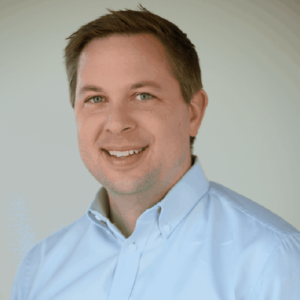
Michael Gryniuk, Associate und Projektmanager bei LeMessurier in Boston
